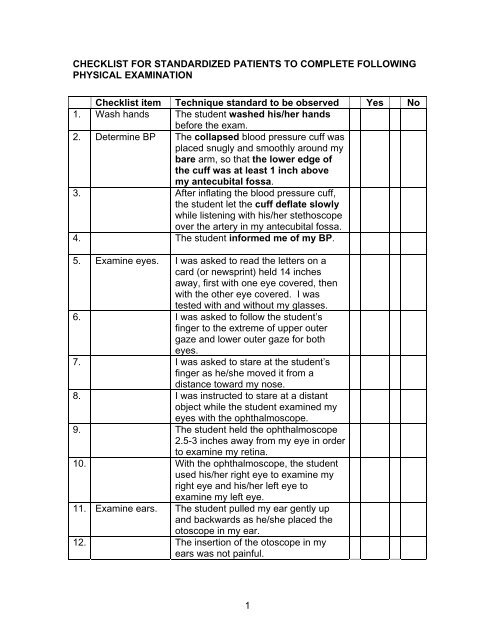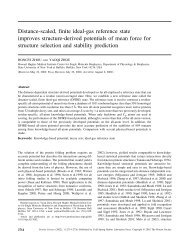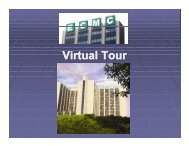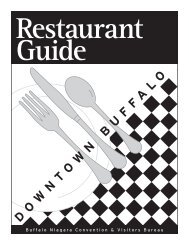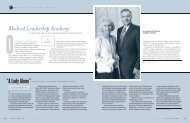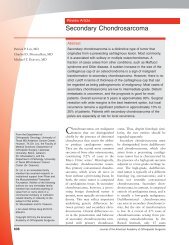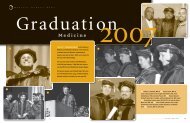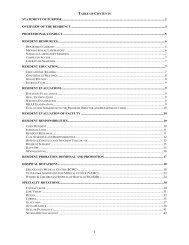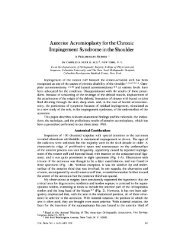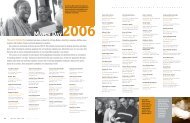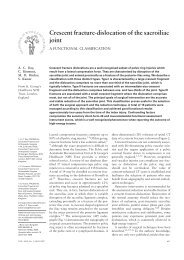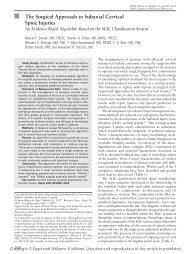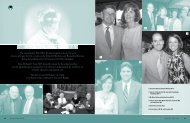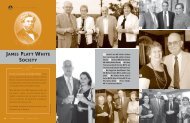Physical Examination
Physical Examination
Physical Examination
Create successful ePaper yourself
Turn your PDF publications into a flip-book with our unique Google optimized e-Paper software.
CHECKLIST FOR STANDARDIZED PATIENTS TO COMPLETE FOLLOWING<br />
PHYSICAL EXAMINATION<br />
Checklist item Technique standard to be observed Yes No<br />
1. Wash hands The student washed his/her hands<br />
before the exam.<br />
2. Determine BP The collapsed blood pressure cuff was<br />
placed snugly and smoothly around my<br />
bare arm, so that the lower edge of<br />
the cuff was at least 1 inch above<br />
my antecubital fossa.<br />
3. After inflating the blood pressure cuff,<br />
the student let the cuff deflate slowly<br />
while listening with his/her stethoscope<br />
over the artery in my antecubital fossa.<br />
4. The student informed me of my BP.<br />
5. Examine eyes. I was asked to read the letters on a<br />
card (or newsprint) held 14 inches<br />
away, first with one eye covered, then<br />
with the other eye covered. I was<br />
tested with and without my glasses.<br />
6. I was asked to follow the student’s<br />
finger to the extreme of upper outer<br />
gaze and lower outer gaze for both<br />
eyes.<br />
7. I was asked to stare at the student’s<br />
finger as he/she moved it from a<br />
distance toward my nose.<br />
8. I was instructed to stare at a distant<br />
object while the student examined my<br />
eyes with the ophthalmoscope.<br />
9. The student held the ophthalmoscope<br />
2.5-3 inches away from my eye in order<br />
to examine my retina.<br />
10. With the ophthalmoscope, the student<br />
used his/her right eye to examine my<br />
right eye and his/her left eye to<br />
examine my left eye.<br />
11. Examine ears. The student pulled my ear gently up<br />
and backwards as he/she placed the<br />
otoscope in my ear.<br />
12. The insertion of the otoscope in my<br />
ears was not painful.<br />
1
13. Examine mouth. The student looked at the sides and<br />
under my tongue.<br />
14. The student asked me to say “ah”.<br />
15. Examine neck<br />
for lymph<br />
nodes.<br />
16. Examine carotid<br />
arteries.<br />
The student palpated the back and<br />
sides of my neck as well as the<br />
supraclavicular fossae (soft, depressed<br />
area above each collarbone).<br />
The student palpated each carotid<br />
artery using his/her index and middle<br />
fingers; only one side was examined at<br />
a time.<br />
17. The student listened over each<br />
carotid artery with his/her<br />
stethoscope.<br />
18. Examine thyroid<br />
gland.<br />
The student used a gentle touch and<br />
placed his/her index/middle fingers<br />
under the strap muscle on each side of<br />
my neck to feel my thyroid gland.<br />
19. The student asked me to swallow<br />
while inspecting and/or palpating my<br />
thyroid.<br />
20. Examine chest The student percussed my chest by<br />
applying one finger firmly against my<br />
chest and tapping against it with a<br />
quick and sudden blow from the middle<br />
finger of his/her other hand.<br />
21. The student percussed on the back of<br />
my chest, alternating from one side to<br />
another as he/she moved down (or up)<br />
my chest.<br />
22. The student asked me to take short<br />
deep breaths through my mouth and<br />
then listened to me breathe by placing<br />
the stethoscope firmly against my<br />
chest. The student listened to me take<br />
a complete breath on each side of my<br />
back, each side of my chest and each<br />
side of the front of my chest.<br />
23. Examine heart. The student felt the apex of my heart<br />
using his/her fingertips.<br />
24. The student listened to my heart in at<br />
least four places with the diaphragm<br />
of his/her stethoscope.<br />
2
25. Examine<br />
abdomen.<br />
The student listened to my abdomen<br />
with his/her stethoscope before<br />
palpating it.<br />
26. The student initially palpated my<br />
stomach lightly and then more deeply,<br />
in all 4 quadrants.<br />
27. The student’s palpation of my<br />
abdomen was not painful.<br />
28. The student stood on my right side<br />
while examining my abdomen.<br />
29. Palpation of<br />
spleen<br />
The student placed his/her left hand<br />
around the lower edge of my left rib<br />
cage and lifted it gently upwards and<br />
then placed his/her right hand under<br />
my left rib cage. He/she asked me to<br />
take a slow deep breath one or more<br />
times while palpating for my spleen<br />
with the right hand. (Some students<br />
may ask you to roll slightly to the right.)<br />
The student appeared comfortable<br />
and/or confident conducting the<br />
physical examination.<br />
The student conducted the examination<br />
in a smooth, well-sequenced manner that<br />
did not require much repositioning on my<br />
part.<br />
The student used a gentle manner when<br />
handling my body, including palpating my<br />
stomach.<br />
The student respected my modesty<br />
through the use of proper draping or<br />
gowning.<br />
The student’s instructions to me were<br />
clear and easy to understand.<br />
The student did an excellent job in<br />
examining me (OVERALL RATING).<br />
Agree<br />
strongly<br />
Agree<br />
Do not agree or<br />
disagree<br />
Disagree<br />
Disagree<br />
strongly<br />
3


